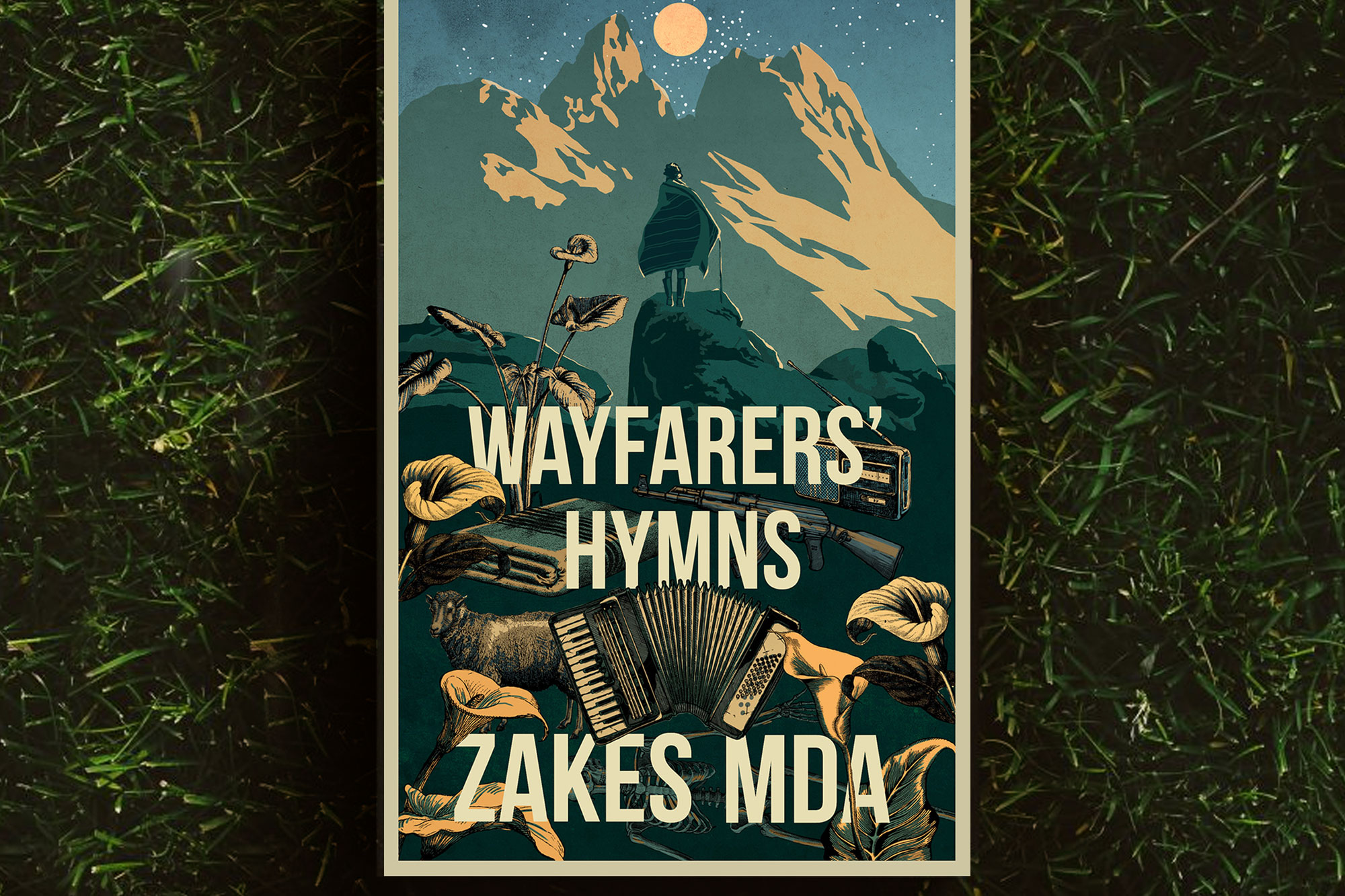Sharp Read | The hymns of a ‘kheleke’
In Wayfarers’ Hymns by Zakes Mda, a boy-child narrates his journey through tradition and modernity, masculinity and the female spirit, old and new as he seeks to emulate a great musician.
Author:
19 October 2021

In January, Zakes Mda tweeted that Mosotho Chakela “of the famo accordion genre” had died of Covid-19. Mda explained that the deceased gangster-singer featured as a character in his forthcoming novel Wayfarers’ Hymns (Penguin) and reminded his followers: “As you know a lot of my fiction features real-life historical and contemporary people as characters.”
Indeed, Mda’s historical fiction is a dance between past and present, a reimagining in 10 novels of the many ways in which colonisation has ravaged South Africa.
The newly published Wayfarers’ Hymns is a paean of praise to the famo music genre. Its history is tied to South Africa’s mining history and the deadly rivalry between mining gangs, musicians and politicians. Famo and the facho dance migrated with the unlicensed Basotho mining gangs of the 1940s whose network stretched from Lesotho to the City of Gold.
We accompany the narrator, the boy-child, on his quest to become a famo singer, a kheleke who performs secular hymns. Backed by accordion and drums, the lyrics of these hymns echo the language of village, clan, traditional leader, of singer and lover. The hymns, like rap music, are poetic, always taking in the overwhelming beauty of the landscape, even when it is barren.
Related article:
The boy-child is enthusiastic and determined and loquacious; he locates us in the complex milieu of famo and its history. He tells of the devastation left by companies who dumped unprofitable mines and of the unlicensed mining communities who made shack settlements out of scrap. He tells how these communities were overtaken by criminal gangs, some of whose leaders were Basotho hymn singers, who performed famo music in drinking dens and continued the tradition of the notorious MaRussia gangs of Soweto in the 1950s.
Wayfarers’ Hymns is the story of a quest. The boy-child wants to become his idol, the great Famole, born Teboho Lesia, who is “among the greatest musicians in the genre”. There is much speculation when Famole, once one of the MaRussia gang leaders, dies, allegedly in a car crash. No respectable gangster should die such a meek death. Famole’s funeral, heavily guarded by the police and military personnel protecting political leaders and government officials, is a who’s who of rivalling musicians, including the aforementioned Khosi Mosotho Chakela. The musician-gangster and businessman had once famously claimed that Famole shot him in Phiri, Soweto, because he was threatened by his success, but the boy-child is sure he’s mistaken.
What better place than Famole’s funeral for Mda to continue the conversation about killing and mourning introduced in Ways of Dying (1995). This novel is where we first met Toloki, the professional mourner, and Noria, the love of his life, and the “strange-looking couple” is here again, to pay tribute to Famole’s music.
New ways of dying
Toloki is a stocky, jaunty tragicomic figure, an odd-bod wanderer who stands out in his trademark velvet and silk costume, top hat, cape and tights, all black, all faded. An ascetic, he swears by his diet of Swiss roll and green onions. During the transition to democracy, when people were exhausted by the proliferation of killings, Toloki found a niche market for his professional lamentation and wailing.
At that time, he met Noria, his village homegirl and childhood crush, after many years, at her son’s funeral. The boy was “necklaced”, a petrol-infused tyre strung around his neck and set alight. Toloki helped Noria to mourn and rebuild her shack when it too was burned down. With wallpaper from the pages of Home and Garden magazine, he created a landscaped haven where together the couple resolved to find new ways of living.
Related article:
In Wayfarers’ Hymns, Noria towers above him, queen-like in her dignity; she’s now his manager. The interim period when Toloki reappeared in the novel Cion (2007), narrating his own story that delves into the tragic legacy of American slavery in Kilvert, a small town in Ohio in the United States, has no real bearing on the action. But that is no matter, as Mda’s novels are not bound by linear time. We find Toloki as we left him in Ways of Dying. In Wayfarers’ Hymns his search for new ways of dying and mourning has brought him to the area encompassing villages including Matelile, Thabana Morena and Likhoele, famous for its musicians and their wars.
The dynamic transitional nature of the story is evident in its contrasts: tradition and modernity, masculinity and the female spirit, old and new. These sometimes clash as the past illuminates but never resolves the present. Yet nothing is set in stone in the world without boundaries that we are about to enter.
‘A dirty world’
Wayfarers’ Hymns is the tale of the boy-child and Moliehi, a brother and sister, and the fluidity of their traditional roles. Their stories become intertwined with those of Toloki and Noria in unexpected ways when the boy-child brings them to the home he shares with his sister. Oddly, in a place of so many killings, Toloki can’t find any takers for his professional mourning, not even when it is free of charge. His body craves mourning, he is compelled to find new killing pastures and leaves Noria behind. He returns to find she has turned their world upside down, living in new and different ways.
The boy-child waxes lyrical and melodious as his high-blown poetic imagery abounds alongside foul language. He praises Moliehi’s “poppy seed beauty” because the genre demands a kheleke praise his sister. Yet he admits to mocking her too: “Oh, Moliehi, lioness of the Bataung clan, the dark one from my mother’s womb … how will I ever get cattle through you when you’re so full of shit?”
Moliehi thinks her brother’s kheleke ambition is a mere pipe dream. Musicians die in the gutter and she would prefer it if he was like “other upright men”, who dig gold and platinum for white men, till their father’s land, marry and have children by the dozen. The boy-child has had a taste of mine work and is not going back.
Moliehi has anyway taken on the harvesting of fields and tending the homestead, and she herself wants to become a famo dancer and later a kheleke. But her brother is having none of it. He tells her, “It is a dirty world out there. I want you to keep your cleanliness. I place you on a pedestal.” She wants none of his protection and has other fish to fry, in particular a female lover.

The woman happens to be Toloki’s beloved Noria. With the mourner out of the picture, she wastes no time in seducing the innocent boy-child. He feels Noria has covered them both “in a blanket of shame” and is even more shocked to learn that he and his sister have shared a lover. Moliehi screams when Noria teasingly suggests that she desires her own brother, but the boy-child later acknowledges he had incestuous thoughts “whether I knew it was her or not. They were about an unknown singer. And the unknown singer was my sister.” These thoughts lead to no consummation, and brother and sister embark separately on journeys beset by conflict and rivalry, corruption, mistrust and even more death.
In death there is laughter, we learned in Ways of Dying, and there seems to be no end to the comic ribaldry and excesses related to funerals. These provide a platform for wonderful burlesque. In one instance, at the funeral of a prominent musician, just as the coffin is about to be lowered, someone pierces the ear with a hymn. A group of gangsters, who have been performing some kind of dance, stop short at the lip of the grave, whip out machine guns from under their blankets and fire into the air.
They point guns at a church minister and the congregation gathered around the grave, and a balaclava-clad gang leader announces: “We have come to kill this man.” He is referring to the corpse and demands that the coffin be opened. When Toloki, doing his best to lament the dead fellow, tells the leader that he’s a fool, he is pushed into the grave. The men have their way with the coffin, firing at it and wrecking its contents. When the security detail, military and politicians fight back, there are casualties including the innocent and Toloki is saved by the grave.
Full circle
The boy-child’s single-minded quest continues. Driven by the imperative of the bones, blood and heart, he marches towards his goal to become a wanderer, a great singer of hymns. He needs to cut a record that will make him rich and famous and silence his detractors, but he needs a mentor and nobody has said it will be easy to find one.
He gets a resounding “no” from Puseletso Seema, aka Mme Mpuse, “once the most famous” famo singer and dancer. She shatters his illusions with revelations of how she was robbed blind by the white men and their Black lackeys in the record business, and how they forced her to become “a woman of the gun”. Now she’s too busy seeking help from her ancestors to help the boy-child.
Maybe Chakela, formerly Rethabile Alexis Mokete, can be such a mentor. The boy-child tries to reach him. Like many caught up in the showbiz of famo, Chakela cuts a comic figure with his face “round like that of a well-fed baby”. This “roly-poly man in a brown coat with a fur collar and a beer belly that defied gravity” was also “masterful in every way I wished I could be”. But Chakela could never trust anyone who had not “gone through the same circumcision school”.
The boy-child is old enough to be the father of some of the circumcision candidates, he says, but the circumcised disdain the uncircumcised, whom they label the maqai. Similarly, homosexuality is disdained, the newly established lesbian couple, Moliehi and Noria, are stamped s’tabani, a derogatory term for homosexuals and Moliehi is beaten to a pulp. Toloki’s own prejudice is laced with superstition, and he believes Moliehi gave Noria muti to make her hate him. For a brief time, the two women can turn things around and the stories of the boy-child and Moliehi come full circle.
Related article:
The boy-child’s struggle continues with his dangerous and eventful journey. After he beds Shoane, she tells Moliehi that he was so tiny “it was like a mouse sitting on a loaf of bread”. Yet he succeeds, at great cost, in becoming a gang leader. But what use is a famous wanderer without feet? A bullet lodged in his spine made him lame and his mouth “ran dry of hymns”, but he insists that the dexterity of his fingers “shows itself in full flight on the accordion. And Moliehi, child of my mother, will sing her hymns to no one else’s accordion but mine.”
Mda acknowledges his research through famo musician and media owner Sebonomoea Ramainoane and conversations with his son, Neo Ndukumfa Solomzi Mda. This rich fount of knowledge, including the music and lyrics of real-life famo musicians, is the source of the boy-child’s explanations and sometimes over-explanations. However, as readers we can be undaunted by the many details of famo’s elaborate history because as the boy-child tells us, when a kheleke is good, one does not need to understand the meaning of the words. “It is enough that they sweep you off your feet.”
He’s right. Listening to some of the songs named in Wayfarers’ Hymns makes for an unusual, vibrant, interactive experience. We’ll never know everything about the genre because there are new voices that “have taken our idiom based on rural Lesotho culture and mine culture and given it a modern urban twist” that will keep them relevant. Some say the new famo music is like “bubblegum that you chew before the sweetness runs out”, because tradition lasts forever. The boy-child says tradition is a process and nothing stays the same.
What does stay the same are the conditions endured by “we of the margins”, the boy-child’s community. Throughout this crazy story, with its descriptions of demented accordion music, awkward arthritic dances and often bawdy humour, its vulgarity and grotesquerie, the message is clear. At funerals, where the “important” people dine in tents, their plates laden with chakalaka, green salads and beetroot, the marginalised still dip their hands into large basins filled with samp. There has been no redress, no reparation, and the “vulgus” is still waiting for freedom.
Wayfarers’ Hymns was published on 16 October.



